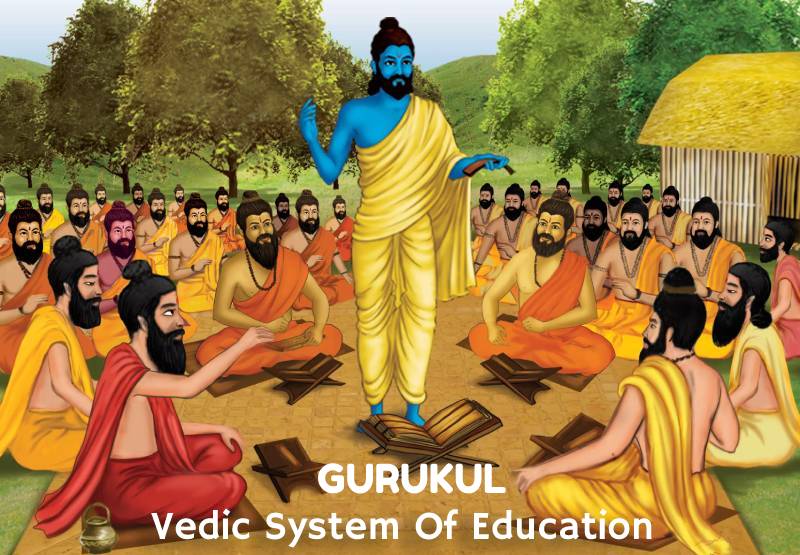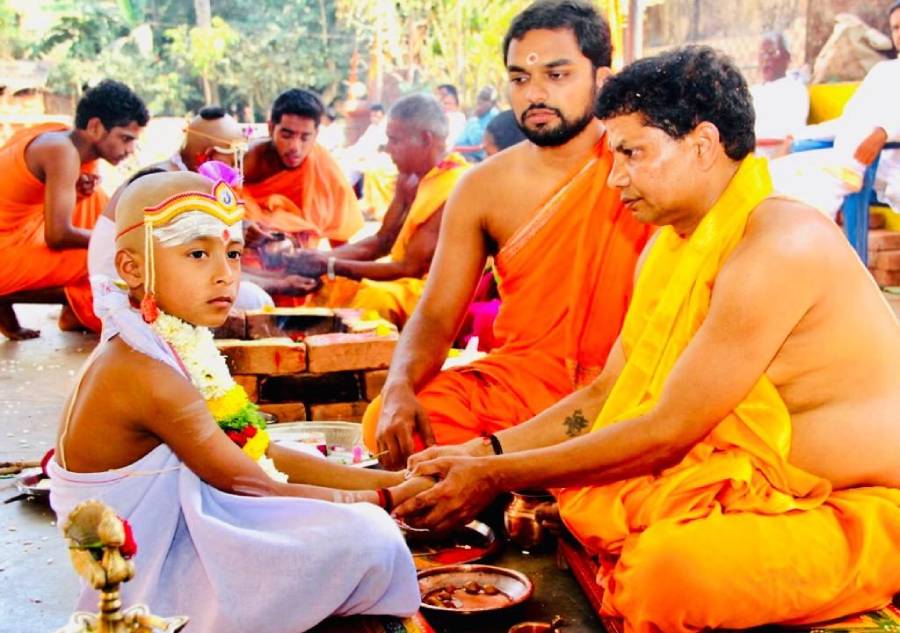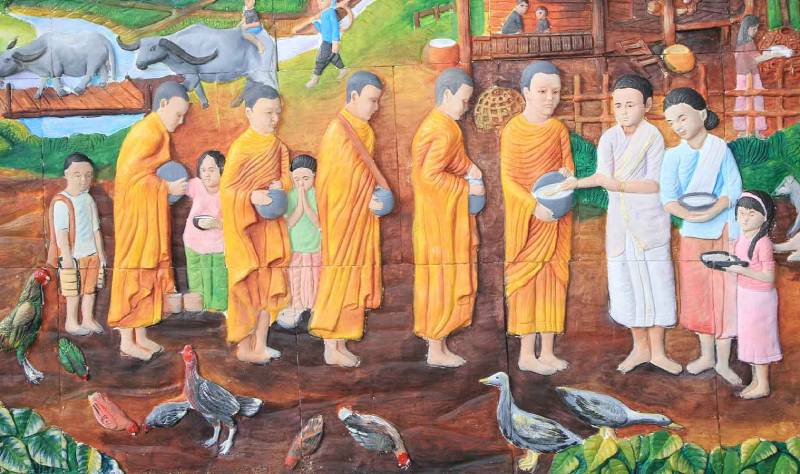What is an Ashram: The term “ashram” is derived from the verb root “श्रम्”, which means “to strive hard or exert effort.” It is the second most important Hindu social organisation. As a result, the Ashramas are the stages in which hard work or effort is required. Ashrama has to do with education and training.

Ancient Indian social thinkers separated human existence into four stages termed Ashram: Brahmacharya, Grihastha, Vanaprastha, and Sanyasa. An Ashrama is one of four age-based life stages in Hinduism that are discussed in ancient and mediaeval Indian scriptures. The Ashrama Upanishad, Vaikhanasa Dharmasutra, and later Dharmashastra present these as sequential stages of human life with age recommendations, whereas the early Dharmasutras presented the Ashramas as four alternative available ways of life, neither presented in a sequential manner nor with age recommendations.
Purushartha and Ashram
The Ashramas system is one part of Hinduism’s complex. Dharma idea, which is connected with the notion of Purushartha, or the four proper objectives of life in Hindu philosophy, namely Dharma (piety, morality, and duties), Artha (creativity), and Dharma (piety, morality, and obligations) (wealth, health, means of life), Kama (love, relationships, emotions), and Moksha (liberation, independence, self-realization) Each of the four Ashramas of life is a type of personal and social environment, with ethical norms, duties, and responsibilities for the individual and society at each stage.
The four proper ends of life are given varying degrees of priority in each Ashrama stage, with successive stages considered as steps toward the ideal in Hindu philosophy, namely Moksha.
Neither ancient nor mediaeval Indian literature suggest that any of the first three Ashramas must focus primarily on a single life purpose (Purushartha). The fourth stage of Sannyasa is distinct, and ancient and mediaeval literature agree that the Sannyasa stage of life must be totally devoted to Moksha with the assistance of Dharma.
Dharma is largely held for all periods of life. Moksha is the ultimate noble goal, which should be pursued by everyone at any stage of life. The texts on the other two are ambiguous. With the exception of Kamasutra, most literature gives no recommendations about whether an individual should stress Artha or Kama during what time of life. According to the Kamasutra,
A man’s life span is one hundred years. He should divide that time between three life goals in such a way that they help rather than inhibit each other. In his youth, he should focus on beneficial goals (artha) like learning, in his thirties, on pleasure (kama), and in his later years, on dharma and moksha.
Each Ashrama stage emphasises the four proper purposes of life differently, with successive phases considered as steps toward the ideal in Hindu philosophy, namely Moksha.

Stages of Hindu Ashram System
Brahmacharya Grihastha Vanaprastha and Sannyasa
Stage One: Brahmacharya (student life); It lasts till the age of 25. The bachelor student stage of life was represented by Brahmacharya. Celibacy was practised during this stage, which was centred on education. The learner attended a Gurukul (guru’s residence) and usually lived with a Guru (teacher). Learning science, philosophy, scriptures, and logic, exercising self-discipline, working to earn dakshina to pay the guru, and learning to live a Dharma life (righteousness, morals, duties).
Stage Two: Grihastha (family life) ; It starts from the age of 26 and lasts till 50 yrs of age. This stage refers to an individual’s married life, which included responsibilities such as keeping a home, raising a family, and educating one’s children. Children, as well as maintaining a family-centered and dharmic social life. In a sociological framework, the Grihastha stage was regarded as the most important of all stages. As human beings in this stage sought a virtuous life, they also created food and money that nourished people in later phases of life, as well as progeny who would carry on humanity.
Stage Three: Vanaprastha (retirement life); It starts from the age of 51 and lasts till 76 years of age. The retirement stage occurs when a person transfers home responsibilities to the next generation, takes on an advisory position, and progressively withdraws from society. The Vanaprastha stage was a shift from the life of a householder, with a greater emphasis on artha and kama (money and knowledge), security, pleasure, and sexual gratification to one that focuses more on Moksha (spiritual liberation).
Stage Four: Sannyasa (renounced life); It starts from the age of 76 years and lasts until death. It deals with renunciation of material aspirations and biases, reflected by a condition of apathy and detachment from material life, and generally without any meaningful property or residence, distinguishing the stage (Ascetic). After finishing the Brahmacharya stage of life, anyone could reach this stage, which centred on Moksha, tranquilly, and simple spiritual life.
Now let us see all these four stages in detail:
The Brahmacharya.
Brahmacharya is an Indian religious concept that literally translates to “behaviour commensurate with Brahma.” In basic terms, you’re on Brahma’s path. To acquire Brahmagyan, a person must control his chitta by abstaining from physical or sensual pleasures through word, thought, and deed. Brahmacharya is the first of four Ashrama (age-based stages) of human existence.
From childhood until twenty-five years of age, the brahmacharya (bachelor student) stage of life exists. It was primarily concerned with education, as well as the practice and preparation for future life. Brahmacharya is a concept in Indian religions. The word brahmacharya comes from two Sanskrit roots: Brahman is the name given to deity in the Vedas, the primary Hindu scriptures.
Brahmacharya is a Sanskrit word that signifies “occupation with, proceeding, behaviour, conduct, to follow, to pursue.” This is frequently translated as “activity,” “conduct,” or “behavioural style.” Brahmacharya is a means to an end, not an end in itself. Cleaning, ahimsa, basic life, study, meditation, and voluntary restraints on specific foods (eating only Sattvic food), intoxicants, and sexual behaviour that is no sex at any cost, not even with the mind) are typical. Brahmacharya ashrama lasted around 20–25 years, roughly equivalent to adolescence.

Upon the child’s Upanayana, the young person would begin a life of study in the Gurukula (the Guru’s household) dedicated to learning all aspects of dharma, or “righteous living principles,” which included personal responsibilities towards himself, family, society, humanity, and God, as well as the environment, earth, and nature. This educational period began when the child was five to eight years old and lasted until the child was fourteen to twenty-five years old.
According to the Naradaparivrajaka Upanishad, the Brahmacharya (student) stage of life should begin when a kid is ready to receive instructions from a guru and last for twelve years. The Brahmacharya begins with Upanayana and finishes with the Samavartanam ceremony, after which the graduate might either join the Grihastha (householder) stage of life, or wait, or seek a life of Sannyasa and isolation in the forest like Rishis. In Chapter 234 of the Mahabharata’s Shanti Parva, Vyasa praises Brahmacharya as a vital stage of life for learning. The Grihastha stage is then included as the foundation of society and critical to an individual’s success. Males are not excluded from the student stage of life in the Vedas and Upanishads. In the Atharva Veda, for example, it says: | ( Atharva Veda, 11.5.18) After graduating from Brahmacharya, a young Kanya (female) finds a suitable husband.
In general, there were no age requirements for beginning Brahmacharya in ancient India. Not only young males but even elderly persons resorted to the student stage of life and sought professors who were authoritative in various areas. In Section 5.11 of the Chandogya Upanishad, “rich and learned householders” become Brahmacharis (students) of Rishi Kaikeya to learn about Atman (Soul, inner Self) and Brahman (Ultimate Reality).
The Vedas mention Brahmacharya in terms of lifestyle and stage of life, but the Rigveda refers to these individuals as Muni and Vati. Brahmacharya is discussed more explicitly in Book XI Chapter 5 of the Atharva Veda, which was completed around 1000 BC. This chapter of the Atharva Veda emphasises Brahmacharya as the path to one’s second birth (mind, Self-awareness), with Hymn 11.5.3 depicting the pupil as an embryo when a teacher accepts a Brahmachari.
The concept and practise of Brahmacarya are widely found among the earlier strata of Hinduism’s Mukhya Upanishads, as described in Book 8 of the Chandogya Upanishad. In their discussions of Brahmacharya, the Vedas and early Upanishadic scriptures of Hinduism make no reference to the student’s age at the outset of Brahmacharya, nor of any restrictions on sexual behaviour.
The Grihastha.
The stage of life known as “Grihastha” is preceded by the Brahmacharya (student) stage and followed by the Vanaprastha (retirement, forest dweller, still advising the next generation) stage. According to ancient scriptures, the Grihastha stage of life lasts from around 25 to 50 years.
Grihastha literally means “being in and occupied with home, family” or “householder” in the Hindu ashram system. It follows the Brahmacharya (bachelor student) life stage, and embodies a married life, with the responsibilities of maintaining a home, raising a family, educating one’s children, and leading a household, as well as a dharmic social life.

In Indian philosophy, the householder stage is characterised by the strongest physical, sexual, emotional, occupational, social, and material attachments in a person’s life. In Indian traditions, the Grihastha stage of life is a suggestion rather than a requirement; any Brahmacharya may skip the householder and retirement stages and proceed directly to the Sannyasa stage of life, renouncing worldly and materialistic pursuits and dedicating their lives to spiritual pursuits.
The Sanskrit word Grihastha is a compound “Grih-astha” made up of two basic words, Grih and Astha. Grihastha means “being in and engaged with home, family” or simply “householder.” Grih means “home, family, house,” while Asth means “devoted to, occupied with, being in.”
It identified four stages of human life, each with distinct differences based on natural human needs and desires, as well as how these stages interacted with the four Purushartha goals of life: Dharma (piety, morality, duties), Artha (wealth, health, means of life), Kama (love, relationships, emotions), and Moksha (enlightenment) (liberation, freedom, self-realization).
Grihastha is the most intense of the four stages, in which a man or woman pursues all four life goals, with a focus on the first three – Dharma, Artha, and Kama. After a Hindu wedding, a man or woman would enter the Grihastha stage, where they would create a home, raise a family, gain wealth, enjoy worldly life, and contribute in society by qualities like philanthropy.
Vanaprastha (forest dweller, retired) and Sannyasa are the stages of Ashrama that are conceptually followed by this stage (renunciation). This stage of life was critical in completing a human being’s full development and meeting all of the individual’s and society’s needs. In Hinduism’s ancient and mediaeval texts, the Grihastha stage is considered the most important of all stages in terms of sociology, because human beings in this stage not only pursue a virtuous life but also produce food and wealth that sustains people in other stages of life, as well as the offspring that continue mankind.
All four stages of life are discussed in the Chandogya Upanishad and Vedanta Stras: student, householder, retired/hermit, and ascetic. Some Upanishad chapters, such as hymn 4.4.22 of the Brihadaranyaka Upanishad, simply mention three stages of human life: Brahmacharya, Grihastha, and Vanaprastha, with no mention of gender, class, or caste constraints. As a road to Brahman, all three steps are suggested (inner Self, Soul). Later scriptures, on the other hand, define four stages of human life.
Grihastha ashram is the basis of all ashrams, according to Gautama Dharmasutra in verses 3.2 and 3.3, and is necessary for the existence and continuation of society because the other three ashrams do not have any children. In Sections VI.87 through VI.90 of Manusmriti, it is stated that the householders feed all those in the other three phases of life, and those who seek spiritual pursuits live on, and those who accept and succeed in Grihastha ashram find contentment.
In lines III.77 to III.80, Manusmriti declares the Grihastha stage to be noble and excellent, and that, just as all creatures need air to survive, all beings take life from the Grihastha Ashram because of the food they make and the wisdom they apply. Manusmriti writes in Sections IV.1 through IV.6 that a Brahmana, after being twice-born and complete renunciation and a commitment to spiritual matters.
The Vanaprastha.

The third stage, Vanaprastha, as defined by the birth of grandchildren, the progressive transfer of householder obligations to the next generation, a more hermit-like lifestyle, and a greater emphasis on community service and spiritual study.
The Vanaprastha stage eventually gave way to Sannyasa, a state of total renunciation and devotion to spiritual matters. Vanaprastha lived between the ages of 51 and 75, according to the Vedic ashram system.
Freedom and personal choice were valued in Hindu beliefs. While the Grihastha and Vanaprastha life stages were suggested, they were not required. Any Brahmacharya may skip the householder and retirement stages of life and proceed directly to the Sannyasa stage, forsaking worldly and materialistic pursuits and devoting their lives to spiritual pursuits.
Life in retirement, Vanaprastha, or the Ashrama system is not mentioned in early Vedic writings. Antigriha (, like a neighbour) is the first reference of a related notion in the Rig Veda, in hymn 10.95.4, where the context and content suggest the elderly did not go into the forest, but continued to live as members of an extended family with an active function in ancient India. Vanaprastha and other new notions originated in the later Vedic age, while previous ideas matured and expanded.
Vanaprastha and Sannyasa arose around or after the 7th Century BC, when sages such as Yjavalkya left their houses and travelled the countryside as spiritual recluses, pursuing their Pravrajika (homeless) lifestyle. The Dharmastras and Dharmastras, written about the mid-1st millennium BC and later, emphasise all four levels of the Ashrama system, including Vanaprastha, with increasing emphasis.
The four Ashramas, including Vanaprastha, are described as “a fourfold division of Dharma” by the Baudhayana Dharmastra in verses 2.11.9 to 2.11.12. According to the Markandeya Purana, a householder is ready to enter the third stage of life, or Vanaprastha, once he has taken care of his progeny, parents, traditions, and purified his mind.
During this stage, he must live simply, sleeping on the floor and eating only fruits and bulbs; the more he gives up worldly pleasures, the closer he gets to knowing his spirit, and the more prepared he is for the final stage, the Sanyas Ashram, where he renounces everything and devotes himself entirely to spiritual pursuits.Vanaprastha is mentioned in a number of ancient Indian literary writings.
The Sannyasa.
Within the Hindu doctrine of four age-based life stages known as ashramas, sannyasa is the life stage of renunciation. Sannyasa is traditionally associated with men and women in their later years of life, however young brahmacharis have had the option of skipping the householder and retirement stages and dedicating their lives to spiritual pursuits instead.
In Hinduism, a person who practises Sanyasa is known as a Sannyasi (man) or Sannyasini (female). In many ways, these are similar to the Jain monastic traditions of Sadhu and Sadhvi. The Buddhist monks and nuns were known as bhikkhus and bhikkhunis. In Indian religions, sannyasa has traditionally been a stage of renunciation, ahimsa (nonviolence), a calm and modest existence, and spiritual pursuit. The phrase Sanyasa appears in the Samhitas, Aranyakas, and Brahmanas, the earliest strata of Vedic literature. In Sanskrit, nyasa implies purification, and sannyasa means “Purification of Everything.”

By the 3rd and 4th centuries CE, the term Sannyasa had evolved into a ceremony of renunciation in ancient Sutra writings, and it had also become a recognised and well-discussed stage of life (Ashrama). Hinduism makes no formal expectations or requirements on the lifestyle, spiritual discipline, method, or deity that a Sanyasin or Sanyasini must follow; it is entirely up to the individual’s choice and preferences. Moksha is the objective of the Hindu Sannyasin (liberation). A permanent Sannyasin, according to Geetaa, is one who does not hate, covet, or have dualities (opposites). Mahabaho (Arjuna) is truly free of his enslavement.
Ahimsa (non-violence), akrodha (not becoming angry even if abused by others), disarmament (no weapons), chastity, bachelorhood (no marriage), avyati (non-desirous), amati (poverty), self-restraint, truthfulness, sarvabhutahita (kindness to all creatures), asteya (non-stealing), aparigraha (non-acceptance of gifts, non-possessiveness) and shaucha (purity of body speech and mind).
Disclaimer: The author’s views are his or her own. The facts and opinions in the article have been taken from various articles and commentaries available in the online media and Eastside Writers does do not take any responsibility or obligation for them.
Note: Contact our Writers at www.eastsidewriters.com for writing Blogs/Articles on any niche. We have experts in various domains from Technology to Finance and from Spirituality to Lifestyle and Entertainment.







I’m curious to find out what blog platform you have been utilizing? I’m experiencing some small security problems with my latest blog and I’d like to find something more risk-free. Do you have any solutions?
Pingback: Yoga - The Vedic Philosophy, Structure And The Inner Engineering. - Eastside Writers
Pingback: Vedic Mantra Helps Reduce Your Anxiety And Depression - Eastside Writers
Pingback: Shilajit- It's Unknown And Untold Wonders in Your Well-Being - Eastside Writers
Pingback: Power Of Trimurti- Preserver Creator and Destroyer of the Cosmic System - Eastside Writers
Pingback: Brahmacharya - TuffSocial
I have been browsing online more than three hours today, yet I never found any interesting article like yours. It’s pretty worth enough for me. In my opinion, if all web owners and bloggers made good content as you did, the web will be a lot more useful than ever before.
Pingback: The Power of Conscience: Upholding Moral and Ethical Values in Our Lives - Eastside Writers